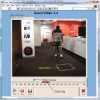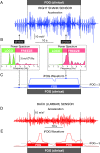Autonomous identification of freezing of gait in Parkinson's disease from lower-body segmental accelerometry
- PMID: 23405951
- PMCID: PMC3598888
- DOI: 10.1186/1743-0003-10-19
Autonomous identification of freezing of gait in Parkinson's disease from lower-body segmental accelerometry
Abstract
Background: We have previously published a technique for objective assessment of freezing of gait (FOG) in Parkinson's disease (PD) from a single shank-mounted accelerometer. Here we extend this approach to evaluate the optimal configuration of sensor placement and signal processing parameters using seven sensors attached to the lumbar back, thighs, shanks and feet.
Methods: Multi-segmental acceleration data was obtained from 25 PD patients performing 134 timed up and go tasks, and clinical assessment of FOG was performed by two experienced raters from video. Four metrics were used to compare objective and clinical measures; the intraclass correlation coefficient (ICC) for number of FOG episodes and the percent time frozen per trial; and the sensitivity and specificity of FOG detection.
Results: The seven-sensor configuration was the most robust, scoring highly on all measures of performance (ICC number of FOG 0.75; ICC percent time frozen 0.80; sensitivity 84.3%; specificity 78.4%). A simpler single-shank sensor approach provided similar ICC values and exhibited a high sensitivity to FOG events, but specificity was lower at 66.7%. Recordings from the lumbar sensor offered only moderate agreement with the clinical raters in terms of absolute number and duration of FOG events (likely due to musculoskeletal attenuation of lower-limb 'trembling' during FOG), but demonstrated a high sensitivity (86.2%) and specificity (82.4%) when considered as a binary test for the presence/absence of FOG within a single trial.
Conclusions: The seven-sensor approach was the most accurate method for quantifying FOG, and is best suited to demanding research applications. A single shank sensor provided measures comparable to the seven-sensor approach but is relatively straightforward in execution, facilitating clinical use. A single lumbar sensor may provide a simple means of objective FOG detection given the ubiquitous nature of accelerometers in mobile telephones and other belt-worn devices.
Figures





References
-
- Fahn S, Elton RL. In: Recent developments in Parkinson's disease. Fahn S, Marsden CD, Goldstein M, Calne DB, editor. Vol. 2. Florham park, NJ: Macmillan healthcare Information; 1987. Unified Parkinson's disease rating scale; pp. 153–163. members. Up.
Publication types
MeSH terms
LinkOut - more resources
Full Text Sources
Other Literature Sources
Medical
Molecular Biology Databases

